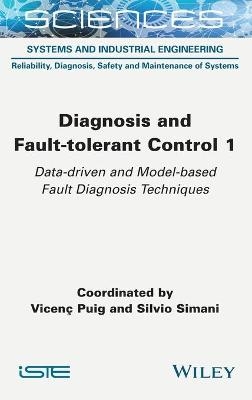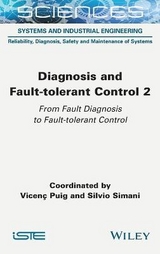
Diagnosis and Fault-tolerant Control 1
Iste Ltd (Verlag)
978-1-78945-058-3 (ISBN)
Diagnosis and Fault-tolerant Control 1 also presents and compares different diagnosis schemes using established case studies that are widely used in related literature. The main features of this book regard the analysis, design and implementation of proper solutions for the problems of fault diagnosis in safety critical systems. The design of the considered solutions involves robust data-driven, model-based approaches.
Vicenc Puig is Professor of Automatic Control at the Universitat Politècnica de Catalunya (UPC), Spain. He has published more than 80 journal articles and more than 350 articles in international conference/workshop proceedings related to diagnosis and faulttolerant control. Silvio Simani is Professor of Automatic Control in the Engineering Department of Ferrara University, Italy. He has published about 260 journal and conference papers, several book chapters and four monographs on fault diagnosis and sustainable control topics.
Introduction ix
Vicenç Puig and Silvio Simani
Chapter 1 Mathematical Modeling and Fault Description 1
Silvio Simani
1.1. Introduction 1
1.2. Model-based FDI techniques 2
1.3. Modeling of faulty systems 3
1.3.1. Fault modeling and description 5
1.3.2. Mathematical description 6
1.4. Residual generation 11
1.5. Residual generation techniques 14
1.5.1. Residual generation via parameter estimation 15
1.5.2. Observer-based approaches 18
1.5.3. Fault detection via parity equations 24
1.6. Change detection and symptom evaluation 28
1.7. Residual generation robustness problem 30
1.7.1. FDI H∞ approach 32
1.7.2. Active and passive disturbance decoupling 35
1.8. Fault diagnosis technique integration 36
1.8.1. Fuzzy logic for residual generation 37
1.8.2. Neural networks for fault diagnosis 38
1.8.3. Neuro-fuzzy approaches to FDI 40
1.8.4. Fault detectability and isolability 42
1.8.5. NF model structure identification 43
1.8.6. NF residual generation for FDI 44
1.9. Conclusion 46
1.10. References 47
Chapter 2 Structural Analysis 57
Mattias Krysander and Erik Frisk
2.1. Introduction 57
2.2. Background 58
2.2.1. Structural models 58
2.2.2. Dulmage–Mendelsohn decomposition and matchings 60
2.2.3. Dulmage–Mendelsohn decomposition and simulation 63
2.3. Fault isolability analysis 64
2.3.1. Fault detectability analysis 64
2.3.2. Fault isolability analysis 65
2.3.3. Canonical isolability decomposition of the overdetermined part 67
2.4. Testable submodels 69
2.4.1. Basic definitions 69
2.4.2. MSO algorithm 71
2.4.3. Residual generation based on matching 72
2.5. Sensor placement 74
2.5.1. The basic sensor placement problem 74
2.5.2. A structural approach 75
2.6. Summary and discussion 80
2.7. References 81
Chapter 3 Set-based Fault Detection and Isolation 83
Ye Wang and Vicenç Puig
3.1. Introduction 83
3.2. Notations, definitions and properties 84
3.3. Problem statement 86
3.3.1. Uncertain discrete-time linear systems 86
3.3.2. Set-based methods 86
3.3.3. FDI problem statement 88
3.4. Proposed techniques 89
3.4.1. Set-membership approach 89
3.4.2. Zonotopic observer 90
3.4.3. Relationship between set-based methods 91
3.5. Design methods 92
3.5.1. Robustness conditions 92
3.5.2. Fault sensitivity condition 96
3.6. Fault detection and isolation procedures 99
3.6.1. Fault detection 99
3.6.2. Fault isolation 100
3.7. Application example: quadruple-tank system 101
3.7.1. Results with robustness condition 105
3.7.2. Results with robustness and fault sensitivity conditions 105
3.8. Conclusion 105
3.9. References 109
Chapter 4 Diagnosis of Stochastic Systems 111
Gregory Provan
4.1. Introduction 111
4.2. Stochastic diagnosis task 113
4.2.1. Notation 113
4.2.2. Problem formulation 113
4.2.3. Representing uncertainty 115
4.3. Inference methods for diagnosis task 116
4.3.1. Difference with other tasks 116
4.4. Model-based approach 117
4.4.1. Traditional FDD methods 117
4.4.2. Bayesian inversion/filtering 120
4.5. Data-driven approaches 122
4.5.1. ML methods 123
4.5.2. Statistical methods 124
4.6. Hybrid approaches: surrogate methods 125
4.6.1. Fitting surrogate models via sampling 125
4.7. Comparative analysis of approaches 126
4.8. Summary and conclusions 127
4.9. References 128
Chapter 5 Data-Driven Methods for Fault Diagnosis 131
Silvio Simani
5.1. Introduction 131
5.2. Models for linear system fault diagnosis 133
5.3. Parameter estimation methods for fault diagnosis 135
5.3.1. Data-driven method in ideal conditions 135
5.3.2. Data-driven methods in real scenarios 138
5.3.3. Algebraic Frisch scheme 139
5.3.4. Dynamic Frisch scheme 141
5.3.5. MIMO case Frisch scheme 145
5.4. Nonlinear dynamic system identification 146
5.4.1. Piecewise affine model 147
5.4.2. Hybrid model structure 148
5.4.3. Nonlinear system approximation 149
5.4.4. Model continuity and domain partitioning 151
5.4.5. Local affine model estimation 154
5.4.6. Multiple-model estimation 158
5.5. Fuzzy data-driven approach to fault diagnosis 164
5.5.1. Fuzzy model identification 165
5.5.2. Takagi–Sugeno prototypes 167
5.5.3. Data-driven fuzzy modeling 170
5.5.4. Clustering methods 170
5.5.5. Fuzzy c-means clustering algorithms 172
5.5.6. Gustafson–Kessel clustering algorithm 174
5.5.7. Optimal number of clusters 176
5.6. Fuzzy model identification 176
5.6.1. Nonlinear model identification 178
5.6.2. Product space clustering identification 181
5.6.3. Fuzzy clustering model identification 183
5.6.4. Antecedent membership function estimation 183
5.6.5. Estimating consequent parameters 185
5.7. Conclusion 189
5.8. References 189
Chapter 6 The Artificial Intelligence Approach to Model-based Diagnosis 197
Belarmino Pulido, Carlos J. Alonso-González and Anibal Bregon
6.1. Introduction 197
6.2. Case studies 199
6.3. Knowledge-based diagnosis systems 201
6.3.1. Diagnosis task and system model 203
6.3.2. Diagnosis of physical devices 206
6.3.3. Limits of KBS for diagnosis of physical devices 207
6.4. Model-based diagnosis 208
6.4.1. Formalization of consistency-based diagnosis and its first implementation, GDE 209
6.5. CBD for dynamic systems 217
6.5.1. Different approaches for CBD of dynamic systems 219
6.5.2. PCs for the three-tank system case study 222
6.6. Conclusion 224
6.7. References 226
List of Authors 231
Index 233
Summary of Volume 2 237
| Erscheinungsdatum | 06.01.2022 |
|---|---|
| Verlagsort | London |
| Sprache | englisch |
| Maße | 10 x 10 mm |
| Gewicht | 454 g |
| Themenwelt | Technik ► Elektrotechnik / Energietechnik |
| Wirtschaft ► Betriebswirtschaft / Management | |
| ISBN-10 | 1-78945-058-6 / 1789450586 |
| ISBN-13 | 978-1-78945-058-3 / 9781789450583 |
| Zustand | Neuware |
| Haben Sie eine Frage zum Produkt? |
aus dem Bereich



